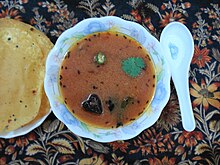
Summary
Rasam is a spicy South Indian soup-like dish.[1] It is usually served as a side dish with rice. In a traditional South Indian meal, it is part of a course that includes sambar rice. Rasam has a distinct taste in comparison to sambar due to its own seasoning ingredients and is fluid in consistency. Chilled prepared versions are marketed commercially as well as rasam paste in bottles.[2]
 | |
| Alternative names | Saaru, saathamudhu, chaaru, chaatambde |
|---|---|
| Place of origin | South India |
| Region or state | Tamil Nadu, Andhra Pradesh, Karnataka, Kerala, Maharashtra, Telangana, Odisha |
| Serving temperature | Hot |
| Main ingredients | kokum, kadam, jaggery, tamarind, tomato, lentil |
| |
An Anglo-Indian variety of rasam is the soup-like dish mulligatawny whose name is derived from the Tamil word mulagu thani.[3]
Origin edit
Rasam in Malayalam and Tamil, Tili sāru in Kannada (Kannada script: ತಿಳಿ ಸಾರು), or chāru(చారు) in Telugu means "essence" and, by extension, "juice" or "soup". In South Indian households rasam commonly refers to a soupy dish prepared with a sweet-sour stock made from either kokum or tamarind, along with tomato and lentil, added spices and garnish.
Ingredients edit
Rasam is prepared mainly with a tart base such as kokum, malabar tamarind (kudam puli), tamarind, vate huli (vate huli powder), ambula or amchur (dried green mango) stock depending on the region. A dal or lentil stock (for rasam, the typical dal used is split yellow pigeon peas or mung beans) is optional but is used in several rasam recipes. Jaggery, cumin, black pepper, turmeric, tomato, lemon, mustard seeds, chilli powder, curry leaves, garlic, shallots and coriander leaves may be used as flavoring ingredients and garnish in South India.
Types edit
Different kinds of rasam are listed below with their main ingredients.
- Koẕi rasam – chicken
- Kaḍalai rasam – black chickpeas
- Venkāya rasam – Eggplant
- Kattu sāru – Togari bele and Byadgi chillies[4]
- Huruli sāru - made from Horsegram (Kudu in Tulu)[5]
- Tili sāru – sieving water from plain rice
- Thakkāḷi rasam – tomato puree
- Pūndu rasam – garlic
- Inji rasam – ginger
- Panasa tona charu - jackfruit (ripe)
- Mudakathān rasam – balloon vine
- Māngā rasam – raw or semi-ripe mango
- Elumichai rasam – lemon juice
- Nellikkāi rasam – Indian gooseberry
- Murungai pū rasam – drumstick flower
- Vēpam pū rasam – neem flower
- Kandathippili rasam – greens
- Bassāru/kattu sāru – boiled vegetables/greens/lentils
- Miḷagu rasam (mulligatawny) – black pepper
- Jīraga rasam – cumin
- Beetroot rasam
- Black pepper sāru – Black pepper (Karimenasu in Kannada)[6]
- Puḷi rasam – kokum or tamarind extract
- Hesaru kālu sāru – green gram
- Paruppu rasam / pappu sāru – pulses and tomato stock
- Baellae sāru – pigeon pea lentil
- Kattina sāru – jaggery
- Mysore rasam – fried lentils[7]
See also edit
References edit
- ^ "Rasam - Recipes, Food & Drink - The Independent". Archived from the original on 2 November 2009. Retrieved 4 April 2014.
- ^ "NRN-funded startup to retail rasam, sattu in packs". The Times Of India. Retrieved 25 December 2014.
- ^ "Mulligatawny soup, meatball curry and more: The hybrid culinary inventions of Anglo-Indians". The New Indian Express. Retrieved 1 November 2023.
- ^ "Tovve,Kattu Saaru,Dal recipe". Udupi-recipes. Retrieved 9 January 2020.
- ^ "Horsegram Rasam,Huruli Saaru,Kudu Saaru recipe". Udupi-recipes. Retrieved 9 January 2020.
- ^ "Nursing Mother Foods-black-pepper rasam recipe". Udupi-recipes. Retrieved 9 January 2020.
- ^ "Mysore Rasam Recipe, Mysore Soup, Mysore Charu, Yogari Bele Saaru, Mysore Sathamudhu, Mysore Dal Tamarind Curry, Mysore Saru, Mysore Chaaru, Mysore Lentil Soup". Rasam.co.in. Retrieved 18 January 2014.


